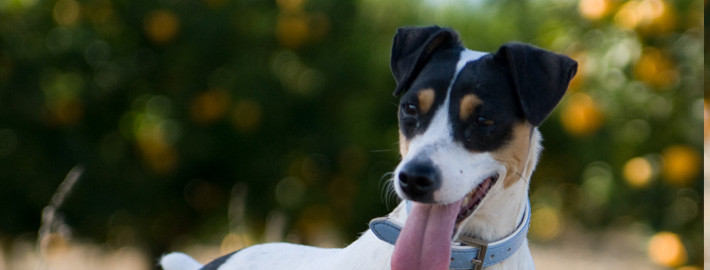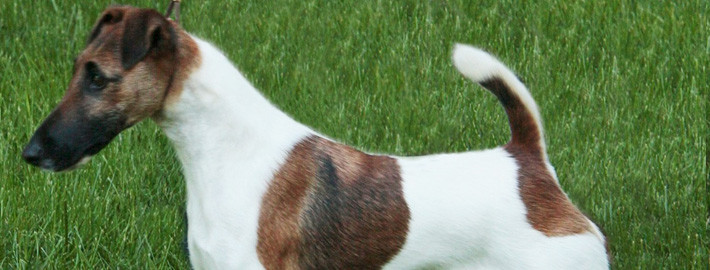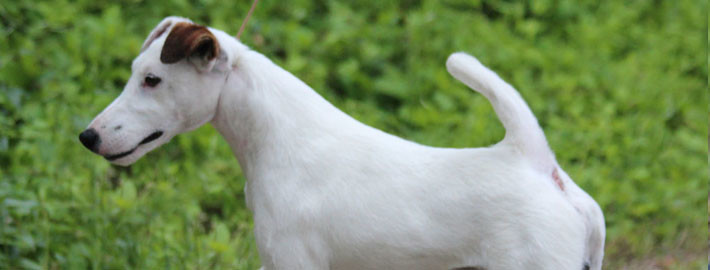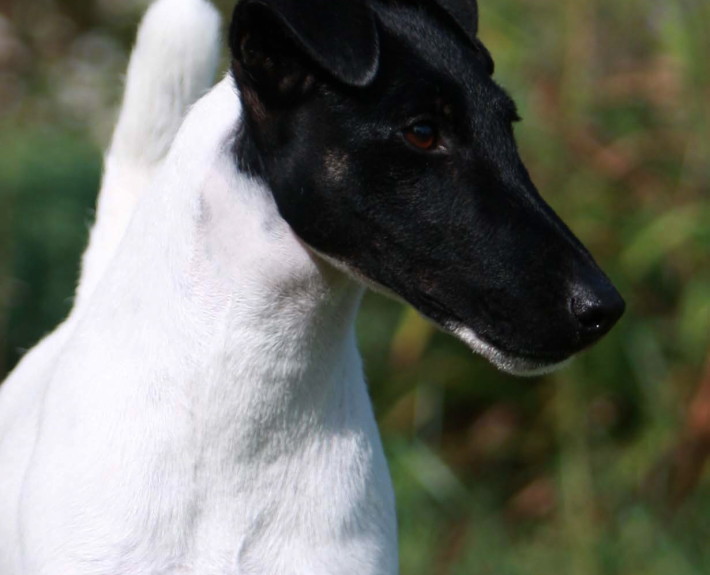What makes the Smooth Fox Terrier Unique?
The smooth fox terrier is square-proportioned, standing over a lot of ground but with a short back. Its conformation combines speed, endurance and power, enabling it to gallop and stay with the horses and hounds during the hunt and to follow a fox up a narrow passage. The gait while trotting gets most of its propulsion from the rear quarters. The expression, like the attitude, is keen; the carriage is alert and expectant. The coat is flat, hard and dense, also with a short, fine undercoat.
Energetic, inquisitive, bold, feisty, playful, mischievous, independent and adventurous describe the fox terrier. This breed lives to run, chase and explore. It is usually fairly reserved with strangers. It tends to bark and dig.
Page Contents
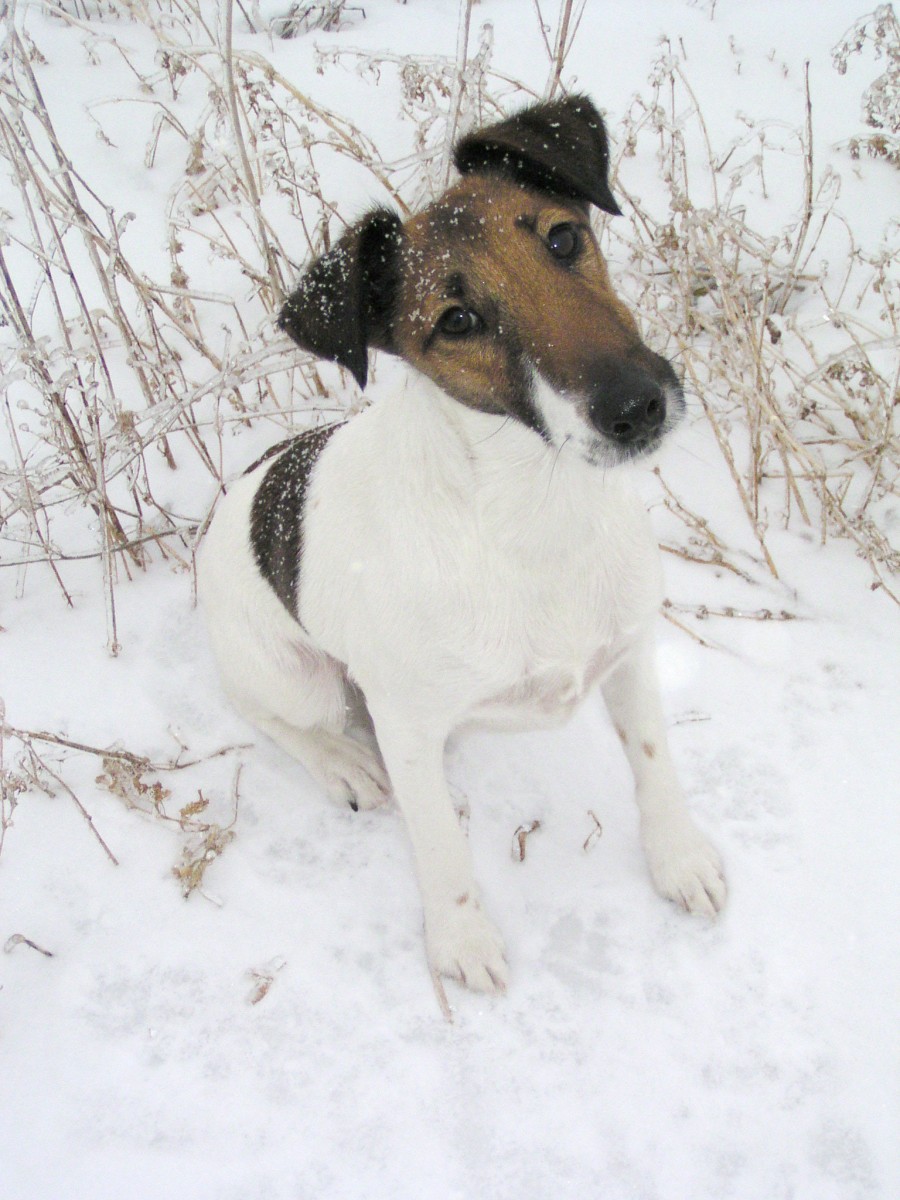
Is the Smooth Fox Terrier Right For You?
The Smooth Fox Terrier has a sleek, easy to maintain coat. Its sturdiness and size combined with its friendly and playful nature make it an excellent companion for children. They are bold but not aggressive towards people. Fox Terriers make excellent watch dogs in the home. New owners should be aware that the breed’s innate sense to dig may affect the family yard or flower beds unless the dog is taught otherwise.
If you are considering purchasing a Smooth Fox Terrier puppy, learn more here.
*Terrier Group; AKC recognized in 1885.
*Should not exceed 15½ inches tall at the shoulder and 18 pounds.
*Vermin hunter.
In 5 Words
- Playful
- Fearless
- Intelligent
- Active
- Affectionate
Characteristics
Learn About the Smooth Fox Terrier
Description
The Smooth Fox Terrier is a medium-sized dog. The skull is flat, moderately narrowing to the eyes. The stop is slight. The muzzle gradually tapers to the black nose. The teeth should meet in a scissors bite. The eyes and eye rims are dark in color. The small, V-shaped ears drop forward close to the cheeks. The neck is thick and muscular. The legs are straight. The tail is high set and is usually docked by 1/4, leaving 3/4 of the original length. Note: the practice of docking tails is illegal in most parts of Europe. The flat, smooth coat should be dense and abundant. The coat is predominately white with black or brown markings.
Short History of the Smooth
The Fox Terrier has been shown in the United States as one breed with two varieties, the smooth and the wire, since it was first recognized by the American Kennel Club in 1885. In 1984, the AKC approved separate standards for the Smooth Fox Terrier and the Wire Fox Terrier, and breeds were recognized as fully distinct effective June 1, 1995. Experts believe that the two fox terriers developed very differently. The Wire Fox Terrier is thought to have descended from the old rough-coated black-and-tan working terriers of Wales, Durham and Derbyshire. The Smooth Fox Terrier apparently descended from the smooth-coated black-and-tan terrier, the Bull Terrier, the Beagle and the Greyhound. Both the Smooth and the Wire Fox Terrier were bred for their excellence as ratters and as aides to British farmers in eradicating vermin. Traditionally, the fox terriers would go to ground to bolt foxes, where the hunters and their pack of foxhounds would carry on the chase.
The Smooth Fox Terrier was in the show ring 10 to 20 years before its wire-haired cousin. The first class devoted to the Fox Terrier was at a dog show in London in 1862. In 1863, at the Birmingham show, three Fox Terriers known as the founding fathers of the breed were shown. The appearance of Old Jock, Old Tartar and Old Trap in the ring boosted the Fox Terriers’ career as competitive show dogs in addition to their working talents. The two then-varieties were crossed many times, particularly to give more of a white coat color to the Wire Fox and a cleaner silhouette. That practice has been discontinued for many years. However, the mostly white coat has remained, originally desired because dark-coated fox terriers were sometimes mistaken for prey by the hunting hounds when they emerged from bolting the fox from its borough.
By the late 1800s, the Fox Terrier had skyrocketed in popularity to become one of the most popular terrier breeds in all of Britain. In 1873, more than 275 entries were in a single Fox Terrier class at an English show. The Fox Terrier Club of England was created in 1876. So well drafted was its breed standard that it remained virtually unchanged for decades. The American Fox Terrier Club was formed in 1885 and adopted the British standard for the breed. The Fox Terrier was accepted into the American Kennel Club’s Terrier Group, with a Smooth and a Wire variety, that same year. By the early 1900s, the smooth Fox Terrier had become the most popular dog breed in England. By the 1920s, the wire-haired variety gave it a run for its money, and later, both varieties declined in Britain as other terrier breeds became more fashionable for dog fanciers.
Today’s Smooth Fox Terrier retains its hunting instincts and traits, making it arguably less commonly seen as purely a house pet than many other terrier breeds. It excels at flyball, agility and other activities that let it satisfy its natural desires to run, chase and explore. The Smooth Fox Terrier can be stubborn, scrappy, aloof and snappy. Its fanciers, however, understand and value these attributes and adore this fiery little terrier.
Temperament
The Smooth Fox Terrier is a brave and bold terrier. It is cheerful, lovable, enthusiastic and playful, especially with children. Affectionate, very devoted and loyal with the family, it truly enjoys its company. Because of its strong hunting instincts, the Fox Terrier will also hunt and possibly kill other none K-9 animals, such as rabbits and birds, if given the chance. Keep this breed properly leashed or in a completely enclosed area, because the Fox Terrier likes to go off and explore. If the Fox Terrier is properly socialized and introduced it can get along just fine with other dogs. Very intelligent, it can be taught to perform tricks. This is a relatively dominant, very high-energy dog that can become stressed and frustrated without the proper type and amount of exercise, both mental and physical. It not only needs its body exercised but its mind as well. It is paramount you are this dog’s 100%, firm, consistent pack leader. If the dog has meek owners, and they allow this terrier to take over the home, developing Small Dog Syndrome, it will begin to display varying degrees of behavior issues. The issues may include, but are not limited to, dominance challenges, guarding objects or places or even its own food from the owner, excessive barking, jealousy, separation anxiety, destructiveness, dog aggressiveness, willfulness, growling, snapping, biting, untrustworthiness with kids and sometimes adults. It may become ready to charge at all times, scrappy and impulsive, as it attempts to defend ITS top position in the alpha order. These are not Fox Terrier traits, but rather behaviors brought on by the way the dog is treated by the people around it. These behaviors can be corrected as soon as the dog’s instincts are met: stable, firm, consistent rules to follow, limits as to what it is and is not allowed to do, along with a daily pack walk or jog.
Caring for Your Smooth Fox Terrier
General Health
The Smooth Fox Terrier generally lives 12 to 15 years, and can live as long as 19 years. The breed is genetically quite healthy. Some known health problems are deafness, luxating patellas and a variety of eye disorders such as lens luxation, distichiasis, and cataracts. Skeletal problems that can occur include Legge-Perthes disease and shoulder dislocations. Myasthenia Gravis and idiopathic epilepsy have also been reported, as well as goiter.
Grooming & Bathing
The coat of the Smooth Fox Terrier should be brushed once per week with a firm brush to keep the coat in neat condition. They only require bathing as needed, and when the coat is properly maintained with regular brushing, baths are rarely required.
Check the ears on a weekly basis for signs of infection, irritation, or wax build up. Cleanse regularly with a veterinarian-approved cleanser and cotton ball. Brush the teeth at least once per week to prevent tartar buildup and fight gum disease. Additionally, nails should be trimmed once per month if the dog does not wear the toenails down naturally.
Exercise & Training
This breed needs to be taken on a daily, long walk or jog. If it is possible, these dogs will love to run free in a safe area. Keep your dog on a leash if there are small animals around. The urge for these dogs to hunt is strong and they are likely to take off chasing a small animal.

